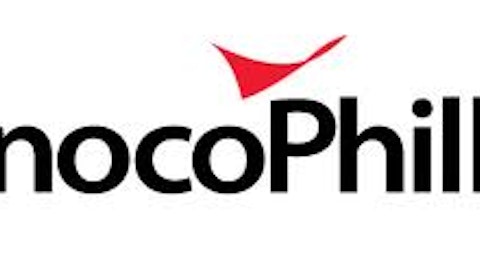
In 1999, exploration and production giants Exxon and Mobil merged to form Exxon Mobil Corporation (NYSE:XOM). Both companies had been industry leaders in innovation, creating revolutionary products like 3-D seismic well-finding technology, synthetic auto lubricant, and the first motor oil that could be used in both summer and winter.
In 2004, when Rex Tillerson took over as CEO, this innovative tradition continued with the Kearl Project in Canada’s oil sands and the acquisition of XTO Energy in June 2012, which gave Exxon Mobil Corporation (NYSE:XOM) access to the emerging natural-gas market.
Clearly, Exxon Mobil Corporation (NYSE:XOM) is a powerful energy company. But what remains for them to do in the future? Well, improving profit margins is one thing that comes to mind. For Exxon, upstream production comprises a vast amount of revenue, as shown by the following graph representing the 2011 fiscal year:

Downstream revenue dominates Exxon’s income statements, providing more than $373 billion of the total $467 billion in revenue that the company saw last year. The revenue numbers associated with downstream oil production are impressive, but before you go put your money into a downstream oil company look at the margins. Exxon’s $41 billion in last year’s profits came from practically everywhere BUT downstream. The graph below represent’s the company’s 2011 profit allocation:

These charts look absolutely nothing alike. Despite the huge dollars coming from Exxon’s downstream segments as revenue, downstream goes almost unnoticed as an earnings driver. So what does this mean to us as investors?
For comparison, we will look to integrated oil company and industry peer ConocoPhillips (NYSE:COP). Conoco’s financial statements experienced many years looking very similar to Exxon’s, with downstream operations bringing in large revenue numbers but lacking in profits.
In 2011, Conoco brought in $186 billion in revenue, which turned into just $3.7 billion of profit. This was the case until April 2012, when Conoco Phillips spun off its downstream segment into a separate company called Phillips 66 (NYSE:PSX), which specializes in the refining and marketing of the oil.
Since the Conoco/Phillips 66 spin-off, the refiner has seen impressive price appreciation, with the stock price rising from $37 per share at the time of its IPO to $57.99 per share on April 17, an increase of nearly 64%. This split also improved Conoco’s margins, as its total revenue fell dramatically but profits only dropped slightly.
Additionally, the specialization which a purely downstream company provides helped to improve the overall profits at the ex-integrated oil company.
In 2011, Conoco’s downstream segment earned approximately $3.8 billion for the company, but once separated into Phillips 66 (NYSE:PSX), the downstream components earned $6.6 billion in their first year of operations. Specialization makes all the difference.
Looking to the future, in 2012 Phillips 66 (NYSE:PSX) announced plans to convert into a Master Limited Partnership, or MLP, structure during the second half of 2013. Meanwhile, a converted focus on unconventional oil sources such as shale oil and bitumen reserves in North America will help to add to Phillips 66 margins in 2013.
ConocoPhillips (NYSE:COP) is placing a larger emphasis on natural gas going into the future, and is very well positioned to take advantage of the liquid natural gas (LNG) market if congress decides to legalize exportation of it.
Most notably, ConocoPhillips (NYSE:COP) owns a 50% interest in LNG company Freeport LNG, a business that is expected to receive government authorization to export liquid natural gas outside of the U.S. at some point in the coming weeks. This will place ConocoPhillips (NYSE:COP) ahead of its peers in the LNG industry, as none of the other major players have the ability to legally export LNG yet.
Now back to Exxon. The energy giant sold it’s Austrian downstream segment in 2010, including 135 service stations. Later, in March 2011 the company sold its Argentinian assets. Again, Rex Tillerson announced in July 2012 that Exxon was exploring the sale of its downstream arm in Germany, a division that includes 1,100 gas stations and would be worth more than 1 billion euros ($1.3 billion).
Obviously Exxon Mobil Corporation (NYSE:XOM) is looking to eliminate its international downstream segments, but is there potential for a spin-off like ConocoPhillips did? Absolutely.
First off, there are no integrated oil companies that are large enough to absorb the costs involved with buying Exxon Mobil Corporation (NYSE:XOM)’s 25,000 distributors and 36 refineries. The only other option for decreasing margins is a spin-off.
The article ExxonMobil – An Upcoming Breakup? originally appeared on Fool.com and is written by Jake Pompeo.
Copyright © 1995 – 2013 The Motley Fool, LLC. All rights reserved. The Motley Fool has a disclosure policy.


